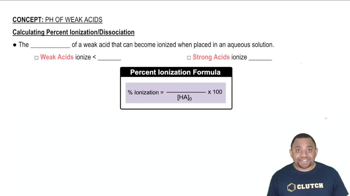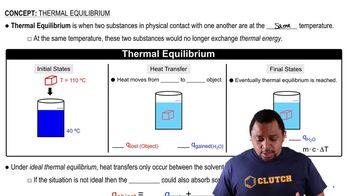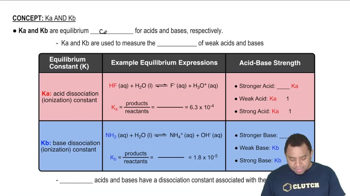Write the chemical equation and the Ka expression for the acid dissociation of each of the following acids in aqueous solution. First show the reaction with H+(a)q as a product and then with the hydronium ion: (a) C6H5COOH (b) HCO3-
Ch.16 - Acid-Base Equilibria
Chapter 16, Problem 57
A 0.100 M solution of chloroacetic acid 1ClCH2COOH2 is 11.0% ionized. Using this information, calculate 3ClCH2COO-4, 3H+4, 3ClCH2COOH4, and Ka for chloroacetic acid.
 Verified step by step guidance
Verified step by step guidance1
Identify the initial concentration of chloroacetic acid, \([\text{ClCH}_2\text{COOH}]_0 = 0.100\, \text{M}\).
Determine the concentration of ionized chloroacetic acid using the ionization percentage: \(0.100\, \text{M} \times 0.110 = [\text{ClCH}_2\text{COO}^-] = [\text{H}^+]\).
Calculate the concentration of non-ionized chloroacetic acid: \([\text{ClCH}_2\text{COOH}] = 0.100\, \text{M} - [\text{ClCH}_2\text{COO}^-]\).
Write the expression for the acid dissociation constant, \(K_a = \frac{[\text{ClCH}_2\text{COO}^-][\text{H}^+]}{[\text{ClCH}_2\text{COOH}]}\).
Substitute the concentrations into the \(K_a\) expression to solve for \(K_a\).

Verified video answer for a similar problem:
This video solution was recommended by our tutors as helpful for the problem above.
Video duration:
3mWas this helpful?
Key Concepts
Here are the essential concepts you must grasp in order to answer the question correctly.
Ionization of Weak Acids
Weak acids, like chloroacetic acid, do not fully dissociate in solution. The degree of ionization indicates how much of the acid has converted to its ions. In this case, an 11.0% ionization means that 11% of the chloroacetic acid molecules have dissociated into ions, which is crucial for calculating concentrations of the species in solution.
Recommended video:
Guided course

Calculating Percent Ionization of Weak Acids
Equilibrium Concentrations
To find the concentrations of the ions and the undissociated acid at equilibrium, we use the initial concentration and the degree of ionization. For a 0.100 M solution that is 11.0% ionized, we can calculate the concentrations of ClCH2COO-, H+, and ClCH2COOH by applying the percentage to the initial concentration, which is essential for determining the acid dissociation constant (Ka).
Recommended video:
Guided course

Thermal Equilibrium
Acid Dissociation Constant (Ka)
The acid dissociation constant (Ka) quantifies the strength of an acid in solution. It is calculated using the equilibrium concentrations of the products and reactants from the ionization reaction. For chloroacetic acid, Ka can be determined using the formula Ka = [H+][ClCH2COO-] / [ClCH2COOH], where the concentrations are derived from the ionization data provided.
Recommended video:
Guided course

Characteristics of Ka and Kb
Related Practice
Textbook Question
Textbook Question
Phenylacetic acid 1C6H5CH2COOH2 is one of the substances that accumulates in the blood of people with phenylketonuria, an inherited disorder that can cause mental retardation or even death. A 0.085 M solution of C6H5CH2COOH has a pH of 2.68. Calculate the Ka value for this acid.
Textbook Question
A 0.100 M solution of bromoacetic acid 1BrCH2COOH2 is 13.2% ionized. Calculate 3H+4, 3BrCH2COO-4, 3BrCH2COOH4 and Ka for bromoacetic acid.
Textbook Question
If a solution of HF 1Ka = 6.8 * 10-42 has a pH of 3.65, calculate the concentration of hydrofluoric acid.
